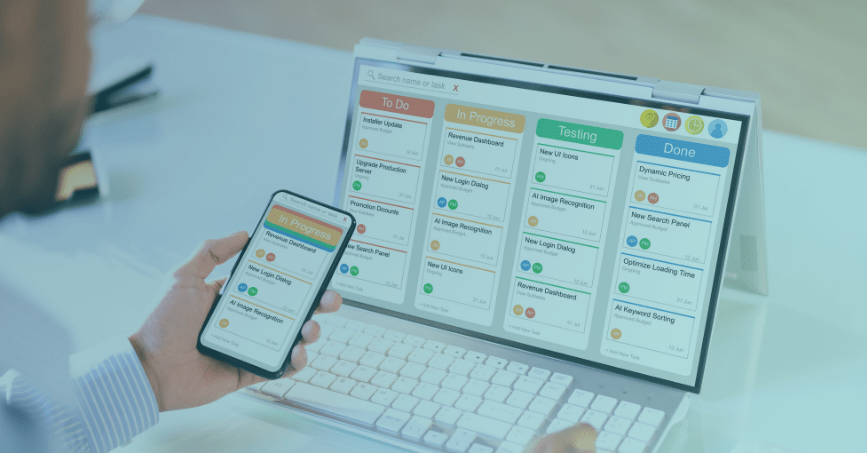Businesses are always looking for methods that will enable them to be more adaptable, effective, customer-focused and flexible in today’s fast-growing, dynamic business environment. These days, more than traditional project management methods that depend on exact planning and execution stages might be required. It is necessary to establish a more flexible and adaptable approach as market conditions change. This is where Agile Project Management (APM) comes in. Agile is a mentality and a set of ideas that helps teams create value gradually while being adaptable. It is not merely a methodology. The complexities of Agile Project Management will be examined in this article, along with its history, fundamental ideas, advantages, and practical applications in a range of sectors.
What is Agile Project Management?
Agile project management is a continuous and adaptive method of project management. It differs from conventional project management techniques, like Waterfall-that adheres to a sequential, linear procedure. Agile is defined by its adaptability, ongoing feedback cycles, and a strong focus on customer satisfaction and teamwork. The Agile Manifesto, written in 2001 by seventeen software professionals looking for alternatives to the time-honored, rigid approaches, is credited with popularizing the word “Agile”.
The Agile Manifesto outlines four key values:
- Individuals and Interactions Over Processes and Tools: Although processes and tools are crucial, people and their interactions are ultimately what makes a project successful.
- Working Software Over Comprehensive Documentation: Documentation is useful but delivering functional software (or any product) that meets customer needs is paramount.
- Customer Collaboration Over Contract Negotiation: Rather than simply adhering to contract terms, Agile promotes ongoing collaboration with customers to ensure the final product aligns with their changing specifications.
- Responding to Change Over Following a Plan: Agile methodologies are designed to be adaptable and responsive to change, rather than strictly following a predetermined plan.
These values are further supported by twelve principles that emphasize aspects such as early and continuous delivery of valuable software, welcoming changing requirements, frequent delivery of working software, and maintaining a sustainable pace of work.
Origins of Agile Project Management
The origins of Agile can be traced back to the software development industry in the 1990s. During this period, developers faced significant challenges with traditional project management methodologies. These conventional approaches often led to projects running over budget, experiencing delays, and failing to meet customer expectations. The frustration with these methodologies led to the creation of new approaches that are focused on flexibility, customer feedback, and iterative development.
In February 2001, seventeen software developers met at a ski resort in Snowbird, Utah, to discuss these new approaches. The outcome of this meeting was the Agile Manifesto, a declaration of the values and principles that underpin Agile methodologies. This manifesto has since served as the foundation for various Agile frameworks, such as Scrum, Kanban, and Extreme Programming (XP). principles that underpin Agile methodologies. This manifesto has since served as the foundation for various Agile frameworks, such as Scrum, Kanban, and Extreme Programming (XP).
Core Principles of Agile
The Agile Manifesto is supported by twelve principles which provide a more detailed explanation of Agile values:
- Our Highest Priority is to Satisfy the Customer Through Early and Continuous Delivery of Valuable Software: Delivering small, functional pieces of software early and frequently ensures that customers receive value throughout the project.
- Welcome Changing Requirements, Even Late in Development: Agile processes harness change for the customer’s competitive advantage.
- Deliver Working Software Frequently, with a Preference for the Shorter Timescale: Frequent delivery cycles, typically ranging from one to four weeks, ensure continuous progress and regular feedback.
- Businesspeople and Developers Must Work Together Daily Throughout the Project: Close, daily collaboration between business stakeholders and developers fosters better communication and understanding.
- Build Projects Around Motivated Individuals: Providing the necessary environment and support, and trusting individuals to get the job done, leads to better outcomes.
- The Most Efficient and Effective Method of Conveying Information is Face-to-Face Conversation: Direct communication minimizes misunderstandings and accelerates decision-making.
- Working Software is the Primary Measure of Progress: Functional software that meets customer needs is the ultimate proof of progress.
- Agile Processes Promote Sustainable Development: Maintaining a constant pace indefinitely is crucial for long-term productivity.
- Continuous Attention to Technical Excellence and Good Design Enhances Agility: High-quality technical practices and well-crafted design enable faster and more reliable development.
- Simplicity – The Art of Maximizing the Amount of Work Not Done – is Essential: Focus on essential tasks and avoid unnecessary work to enhance efficiency.
- The Best Architectures, Requirements, and Designs Emerge from Self-Organizing Teams: Empowered teams that self-organize tend to produce superior outcomes.
- At Regular Intervals, the Team Reflects on How to Become More Effective, Then Tunes and Adjusts its Behavior Accordingly: Continuous improvement through regular reflection and adjustment is fundamental to Agile.
Key Agile Frameworks
Several Agile frameworks have been developed to implement Agile principles in various contexts. Each framework has its unique characteristics and practices:

Scrum is one of the most popular Agile frameworks. It divides the project into fixed-length iterations called sprints, typically lasting 2-4 weeks. Key roles in Scrum include the Product Owner, Scrum Master, and Development Team. The Scrum process involves several ceremonies, such as Sprint Planning, Daily Stand-ups, Sprint Reviews, and Retrospectives.
Roles:
- Product Owner: Represents the stakeholders and is responsible for maximizing the value of the product.
- Scrum Master: Facilitates the Scrum process, helps remove obstacles, and ensures the team adheres to Agile practices.
- Development Team: A cross-functional group of professionals who do the work of delivering a potentially releasable increment of the product at the end of each sprint.
Ceremonies:
- Sprint Planning: The team plans the work to be done during the sprint.
- Daily Stand-ups: Short daily meetings where team members discuss progress and obstacles.
- Sprint Review: A demonstration of the work completed during the sprint to stakeholders.
- Sprint Retrospective: A reflection on the sprint to identify areas for improvement.

Kanban focuses on visualizing work, limiting work in progress, and improving flow. Teams use a Kanban board to represent tasks, which move through columns representing different stages of the workflow. This approach helps identify bottlenecks and optimize processes.
Principles:
- Visualize Work: Use a Kanban board to make work visible.
- Limit Work in Progress (WIP): Restrict the number of tasks in progress to improve focus and flow.
- Manage Flow: Monitor and optimize the flow of work through the system.
- Make Process Policies Explicit: Clearly define and communicate the rules and processes.
- Implement Feedback Loops: Regularly review and adjust processes based on feedback.

Lean Agile principles are derived from Lean manufacturing. Lean focuses on eliminating waste, optimizing processes, and delivering value to the customer. Key principles include value stream mapping, continuous improvement (Kaizen) , and minimizing batch sizes.
Principles:
- Eliminate Waste: Remove any activities that do not add value.
- Build Quality In: Ensure quality at every stage of the process.
- Create Knowledge: Continuously learn and improve.
- Defer Commitment: Delay decisions until they are necessary and well-informed.
- Deliver Fast: Deliver products quickly to meet customer needs.
- Respect People: Empower and respect team members.
- Optimize the Whole: Focus on the entire value stream, not just individual parts.

XP is an Agile framework that emphasizes technical excellence and customer satisfaction. It includes practices such as Test-Driven Development (TDD), Continuous Integration, and Pair Programming. XP aims to improve software quality and responsiveness to changing requirements.
Practices:
- Test-Driven Development (TDD): Write tests before coding to ensure functionality.
- Continuous Integration (CI): Frequently integrate code changes to detect issues early.
- Pair Programming: Two developers work together on the same code to improve quality.
- Refactoring: Continuously improve the code structure without changing its behavior.
- Small Releases: Deliver small, frequent releases to provide value early and often.
Challenges and Solutions in Agile Project Management
Agile project management could change how teams provide value, raise the standard of their output, and increase client happiness. But adopting Agile is not always easy and might come with several challenges. These challenges are frequently caused by the necessary culture shift, the requirement for new competencies, and the core distinctions between Agile and conventional project management techniques. It takes understanding these issues and putting good solutions in place for an Agile transition.
This section will focus on some of the most typical problems teams face while implementing Agile Project Management and offering workable fixes. Organizations may fully experience the benefits of Agile and establish a more flexible, cooperative, and effective work environment by tackling these issues head-on.
- Resistance to Change: Team members and stakeholders may resist adopting new methodologies. Solution: Provide training, support, and demonstrate the benefits of Agile through successful pilot projects.
- Lack of Experience: Teams may struggle with Agile practices due to a lack of experience. Solution: Invest in training, hire experienced Agile coaches and encourage a culture of learning and experimentation.
- Inadequate Communication: Agile relies on effective communication and collaboration. Solution: Use collaboration tools, hold regular meetings, and promote an open and transparent communication culture.
- Scope Creep: Frequent changes in project scope can be challenging to manage. Solution: Prioritize tasks, use a backlog to manage changes and involve stakeholders in prioritization decisions.
Conclusion
Agile Project Management offers a flexible, collaborative, and customer-focused approach to managing projects. By following Agile principles and practices, organizations can improve their ability to adapt to change, deliver high-quality products, and enhance customer satisfaction. Whether you choose Scrum, Kanban, Lean, or XP, the key to successful Agile implementation lies in continuous improvement, effective communication, and a commitment to delivering value.

